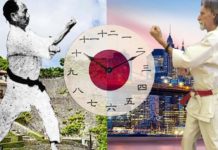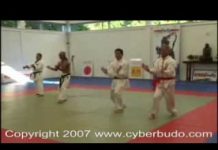This article is in response to John Hancock’s article, Quest For The Truth : The Origin Of Tang Soo Do’s Forms
By Brad Dennison ~ It is extremely possible that while Hwang Kee might have gained some of the Funakoshi perspective on the Pyong Ahn forms and others from an early book by Funakoshi, there also appears to be much Shito Ryu influence in the Tang Soo Do variation of these forms. Such as: Funakoshi ends the first Heian (Pyong Ahn) form with four mid-level sudo (shuto) blocks, not four low-level sudo blocks. His is the only version I have ever seen like this. All of the other versions use the low-level blocks. Since Tang Soo Do also uses the low-level blocks, it would appear that there is Okinawan influence. Since Tang Soo Do uses full side kicks in Pyong Ahn 2 and 4, an apparent Shotokan influence is seen, as Shotokan is the only version I have seen to use side kicks. The Okinawan versions all use front kicks.
It is very possible Hwang Kee picked up the Pyong Ahn forms and possibly some others from Yamaguchi in Manchuria, and then adjusted these forms from other influences, such as Funakoshi’s early book, and maybe even some Chinese martial arts he observed or received a little training in while in Manchuria.
To claim a martial art like karate as solely Korean, or Japanese or even Okinawan is really a bit of a stretch, since the techniques and even many of the root kata, such as Bassai/Bal Sek and Gojushiho, originated in China. True, variations of the forms developed in Okinawa, then further in Japan or Korea, but too much national pride can actually impede historical research. True, modern Tang Soo Do was assembled in Korea, and modern Shotokan in Japan, but it is all, when you get down to the brass tacks, Chinese. Just like Ed Parker’s American Kempo is truly Chinese.
Having said all of this, a kung fu instructor on the west coast once said (and I paraphrase) that the history of the forms is not as important as learning the forms, practicing them, and growing within them. He was speaking of Northern Shaolin, but the same could be said of any of the various Karate/Tang Soo Do styles out there.
By Brad Dennison





Comments are closed.